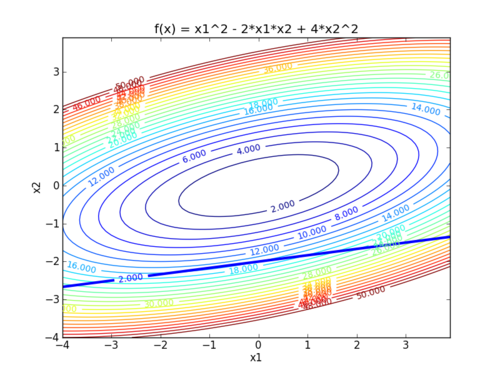Karush-Kuhn-Tucker (KKT) Conditions
The optimality conditions for a constrained local optimum are called the Karush Kuhn Tucker (KKT) conditions and they play an important role in constrained optimization theory and algorithm development. The KKT conditions for optimality are a set of necessary conditions for a solution to be optimal in a mathematical optimization problem. They are necessary and sufficient conditions for a local minimum in nonlinear programming problems. The KKT conditions consist of the following elements:
For an optimization problem:
$$\min_x f(x)$$ $$\mathrm{subject\;to}\quad g_i(x)-b_i \ge 0 \quad i=1,\ldots,k$$ $$\quad\quad\quad\quad\quad g_i(x)-b_i = 0 \quad i=k+1,\ldots,m$$
There are four KKT conditions for optimal primal `(x)` and dual `(\lambda)` variables. The asterisk (*) denotes optimal values.
1. Primal Feasibility: All constraints must be satisfied.
$$g_i(x^*)-b_i \mathrm{\;is\;feasible}$$
2. No Feasible Descent: No possible objective improvement at the solution.
$$\nabla f(x^*)-\sum_{i=1}^m \lambda_i^* \nabla g_i\left(x^*\right)=0$$
3. Complementarity: The product of the Lagrange multipliers and the corresponding variables must be zero.
$$\lambda_i^* \left( g_i(x^*)-b_i \right) = 0$$
4. Dual Feasibility: The Lagrange multipliers associated with constraints have to be non-negative (zero or positive).
$$\lambda_i^* \ge 0$$
The feasibility condition (1) applies to both equality and inequality constraints and is simply a statement that the constraints must not be violated at optimal conditions. The gradient condition (2) ensures that there is no feasible direction that could potentially improve the objective function. The last two conditions (3 and 4) are only required with inequality constraints and enforce a positive Lagrange multiplier when the constraint is active (=0) and a zero Lagrange multiplier when the constraint is inactive (>0).
Part 1: Tutorial on the KKT Conditions
This 5 minute introductory video reviews the 4 KKT conditions and applies them to solve a simple quadratic programming (QP) problem with:
- 1 Quadratic objective function
- 2 Linear equality constraints
- 3 Variables (x1, x2, x3)
Download the following worksheet on KKT conditions. The video below reviews the solution to this worksheet.
Part 2: KKT Conditions with Inequality Constraints
This next 5 minute introductory is similar to the previous one but solves a problem with inequality constraints instead of equality constraints. The problem is a simple quadratic programming (QP) problem with:
- 1 Quadratic objective function
- 2 Linear inequality constraints
- 3 Variables (x1, x2, x3)
Download the following worksheet on KKT conditions with inequality constraints. The video below reviews the solution to this worksheet.
Part 3: KKT Exercise with both Inequality and Equality Constraints
This 5 minute exercise is similar to the previous ones but solves a problem with both equality and inequality constraints.
Download the following worksheet on KKT conditions with inequality and equality constraints. The video below reviews the solution to this worksheet.
Part 4: Application Exercise for the Optimal Volume of a Tank
This 5 minute exercise covers an application to a tank volume optimization. In this case, we specify the final Lagrange multiplier of $8/ft3.
Download the following worksheet on this application of the KKT conditions. The video below reviews the solution to this worksheet.
Part 5: KKT Conditions for Dynamic Optimization
 This assignment can be completed in groups of two. Additional guidelines on individual, collaborative, and group assignments are provided under the Expectations link.
This assignment can be completed in groups of two. Additional guidelines on individual, collaborative, and group assignments are provided under the Expectations link.
